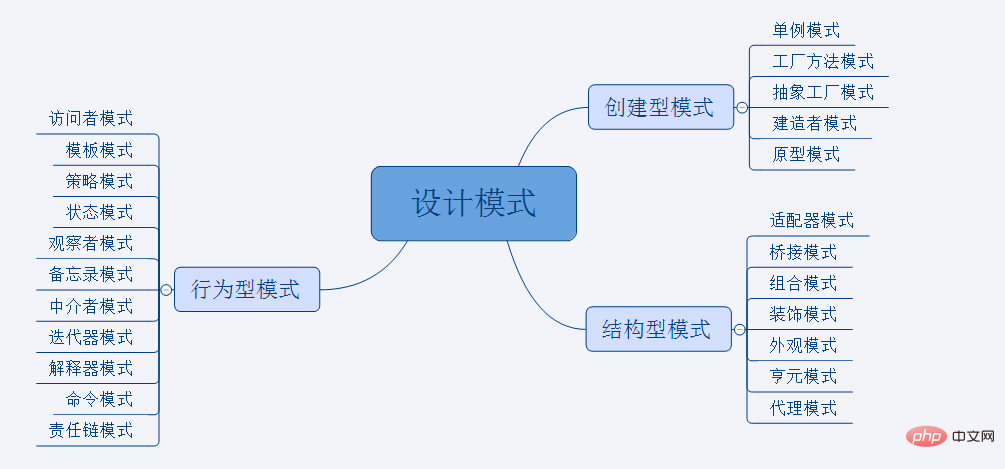what are java design patterns
Design pattern (Design pattern) is a set of classified and cataloged summary of code design experience that is used repeatedly, known to most people. The purpose of using design patterns is to reuse code, make the code easier to understand by others, and ensure code reliability.

There is no doubt that design patterns are win-win for ourselves, others and the system. Design patterns make code compilation truly engineering. Design patterns are the cornerstone of software engineering. Just like the bricks and stones of a building. Reasonable use of design patterns in projects can perfectly solve many problems. Each pattern has a corresponding principle to correspond to it. Each pattern describes a problem that keeps recurring around us, and the core of the problem. solution, which is why it is widely used. To put it simply:
Pattern: In certain scenarios, a certain general solution to a certain type of problem.
Scene: The environment where the project is located
Problem: Constraints, project goals, etc.
Solution: Universal, reusable design, solve constraints to achieve goals.
# Design mode of design mode
: The mode of instantiated objects, the creation mode is used for the instantiated process of decoupled objects.
Structural pattern: Combining classes or objects together to form a larger structure.
Behavioral pattern: how classes and objects interact, and how to divide responsibilities and algorithms.

##Key points of the patterns in each category An instance provides a global access point. Simple factory: A factory class determines which instance of the product class to create based on the parameters passed in.
Factory method: Define an interface for creating objects and let the subclass decide which class to instantiate.
Abstract Factory: Creates a family of related or dependent objects without explicitly specifying a concrete class.
Builder pattern: Encapsulates the construction process of a complex object and can construct it step by step.
Prototype mode: Create new instances by copying existing instances.
Adapter pattern: Convert the method interface of a class into another interface that the customer wants.
Combined mode: Combine objects into a tree structure to represent the ""part-whole"" hierarchy.
Decoration mode: Dynamically add new functions to objects.
Proxy mode: Provide a proxy for other objects to control access to this object.
Hengyuan (fly volume) mode: effectively supports a large number of fine-grained objects through shared technology.
Appearance mode: Provides a unified method to the outside world to access a group of interfaces in the subsystem.
Bridge mode: Separate the abstract part from its implementation part so that they can change independently.
Template pattern: Define an algorithm structure and defer some steps to subclass implementation.
Interpreter pattern: Given a language, define a representation of its grammar, and define an interpreter.
Strategy pattern: Define a series of algorithms, encapsulate them, and make them interchangeable.
State pattern: allows an object to change its behavior when its internal state changes.
Observer pattern: one-to-many dependency relationship between objects.
Memo mode: Maintain the internal state of the object without destroying the encapsulation.
Mediator pattern: Use a mediator object to encapsulate a series of object interactions.
Command mode: Encapsulate the command request as an object so that different requests can be parameterized.
Visitor pattern: Add new functions that act on a set of object elements without changing the data structure.
Chain of responsibility model: Decouple the sender and receiver of the request so that multiple objects have the opportunity to process the request.
Iterator pattern: A method of traversing and accessing each element in an aggregate object without exposing the internal structure of the object.
The above is the detailed content of what are java design patterns. For more information, please follow other related articles on the PHP Chinese website!

Hot AI Tools

Undresser.AI Undress
AI-powered app for creating realistic nude photos

AI Clothes Remover
Online AI tool for removing clothes from photos.

Undress AI Tool
Undress images for free

Clothoff.io
AI clothes remover

Video Face Swap
Swap faces in any video effortlessly with our completely free AI face swap tool!

Hot Article

Hot Tools

Notepad++7.3.1
Easy-to-use and free code editor

SublimeText3 Chinese version
Chinese version, very easy to use

Zend Studio 13.0.1
Powerful PHP integrated development environment

Dreamweaver CS6
Visual web development tools

SublimeText3 Mac version
God-level code editing software (SublimeText3)

Hot Topics
 1387
1387
 52
52
 Perfect Number in Java
Aug 30, 2024 pm 04:28 PM
Perfect Number in Java
Aug 30, 2024 pm 04:28 PM
Guide to Perfect Number in Java. Here we discuss the Definition, How to check Perfect number in Java?, examples with code implementation.
 Weka in Java
Aug 30, 2024 pm 04:28 PM
Weka in Java
Aug 30, 2024 pm 04:28 PM
Guide to Weka in Java. Here we discuss the Introduction, how to use weka java, the type of platform, and advantages with examples.
 Smith Number in Java
Aug 30, 2024 pm 04:28 PM
Smith Number in Java
Aug 30, 2024 pm 04:28 PM
Guide to Smith Number in Java. Here we discuss the Definition, How to check smith number in Java? example with code implementation.
 Java Spring Interview Questions
Aug 30, 2024 pm 04:29 PM
Java Spring Interview Questions
Aug 30, 2024 pm 04:29 PM
In this article, we have kept the most asked Java Spring Interview Questions with their detailed answers. So that you can crack the interview.
 Break or return from Java 8 stream forEach?
Feb 07, 2025 pm 12:09 PM
Break or return from Java 8 stream forEach?
Feb 07, 2025 pm 12:09 PM
Java 8 introduces the Stream API, providing a powerful and expressive way to process data collections. However, a common question when using Stream is: How to break or return from a forEach operation? Traditional loops allow for early interruption or return, but Stream's forEach method does not directly support this method. This article will explain the reasons and explore alternative methods for implementing premature termination in Stream processing systems. Further reading: Java Stream API improvements Understand Stream forEach The forEach method is a terminal operation that performs one operation on each element in the Stream. Its design intention is
 TimeStamp to Date in Java
Aug 30, 2024 pm 04:28 PM
TimeStamp to Date in Java
Aug 30, 2024 pm 04:28 PM
Guide to TimeStamp to Date in Java. Here we also discuss the introduction and how to convert timestamp to date in java along with examples.
 Java Program to Find the Volume of Capsule
Feb 07, 2025 am 11:37 AM
Java Program to Find the Volume of Capsule
Feb 07, 2025 am 11:37 AM
Capsules are three-dimensional geometric figures, composed of a cylinder and a hemisphere at both ends. The volume of the capsule can be calculated by adding the volume of the cylinder and the volume of the hemisphere at both ends. This tutorial will discuss how to calculate the volume of a given capsule in Java using different methods. Capsule volume formula The formula for capsule volume is as follows: Capsule volume = Cylindrical volume Volume Two hemisphere volume in, r: The radius of the hemisphere. h: The height of the cylinder (excluding the hemisphere). Example 1 enter Radius = 5 units Height = 10 units Output Volume = 1570.8 cubic units explain Calculate volume using formula: Volume = π × r2 × h (4
 Create the Future: Java Programming for Absolute Beginners
Oct 13, 2024 pm 01:32 PM
Create the Future: Java Programming for Absolute Beginners
Oct 13, 2024 pm 01:32 PM
Java is a popular programming language that can be learned by both beginners and experienced developers. This tutorial starts with basic concepts and progresses through advanced topics. After installing the Java Development Kit, you can practice programming by creating a simple "Hello, World!" program. After you understand the code, use the command prompt to compile and run the program, and "Hello, World!" will be output on the console. Learning Java starts your programming journey, and as your mastery deepens, you can create more complex applications.




